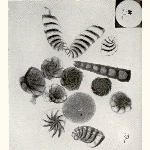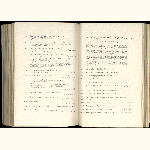Details of exhibit
- Exhibition:
- 1913 Fifty-eighth Annual Exhibition of the Royal Photographic Society of Great Britain
- Exhibit title:
- Micro-radiographs of Foraminifera and Diatoms
- Exhibitor:
- Piérre Goby
- Section:
- III. Scientific and Technical Exhibits, Natural History, Colour Prints, Lantern and Stereoscopic Slides
- Group Title:
- Examples showing the value of Soft X-Rays in Insect Radiography
- Exhibit No.:
- 608
- Description:
- Note by the Author.
By the use of X-Rays - luminous rays imperceptible to the eyes - excellent radiographs of insects and such like objects can be obtained with great delicacy of detail, but, to ensure success, one must use a special kind of X-rays belonging to the class of ultra-soft, or extremely impenetrative rays. An X-ray tube fresh from the maker usually emits soft rays; after a certain amount of use the rays become medium. The rays emitted from a tube vary thus in quality according to the length of time it is in use, and it must be noted that even the soft rays emitted from a new tube are still too penetrant for operations so delicate as those of insect radiography. To make the soft rays less penetrant, the glass must be softened by considerable heat, unless the operator possesses a type of apparatus which can be modified at will during the work. The radiographs on the walls afford sufficient evidence of the delicate detail obtained by the use of ultra-soft rays, since the structure of the wings of cicadas and butterflies can be reproduced with exactitude. Recent work with a tube fitted with a lithium-glass window (from the manufactory of Mr. C. H. F. Muller) has enabled me to obtain the detail, not only of these insects’ wings, but also of their soft tissues. It may be safely said that such results have not hitherto been obtainable by the X-rays, nor even by the use of salts of radium, as regards either the contrasts in the radiographic image or the clearness of definition. - Exhibit type:
- Photograph
- Process:
- [Not Listed] ()
- Award:
- medal
 Picture image: Micro-radiographs of Foraminifera and Diatoms
Picture image: Micro-radiographs of Foraminifera and Diatoms Page image: Micro-radiographs of Foraminifera and Diatoms
Page image: Micro-radiographs of Foraminifera and Diatoms